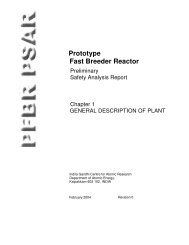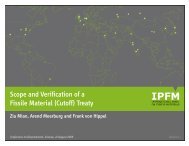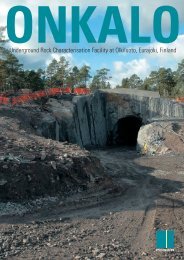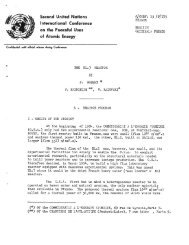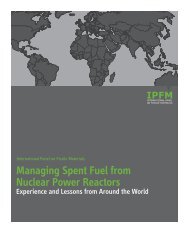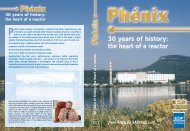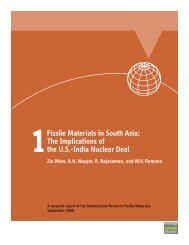Nuclear Proliferation TechnologyTrends Analysis - International ...
Nuclear Proliferation TechnologyTrends Analysis - International ...
Nuclear Proliferation TechnologyTrends Analysis - International ...
You also want an ePaper? Increase the reach of your titles
YUMPU automatically turns print PDFs into web optimized ePapers that Google loves.
PNNL -14480<br />
between the three programs. Initial production from these pilot plants began in 1972 and<br />
full production was reached by early 1976 23 .<br />
From these programs, two were selected to construct initial facilities. One, using<br />
subcritical aluminum centrifuges of Dutch design was constructed in the United<br />
Kingdom; the other subcritical machine of German design using maraging steel was<br />
constructed in The Netherlands.<br />
Urenco machines have been used exclusively for commercial nuclear fuel production.<br />
However, in 1982, the United Kingdom began construction of a facility to be used to<br />
enrich to 20% HEU for use in military programs. This facility (Capenhurst A-3) took<br />
five years to complete and put into production. It produced 20% HEU for seven years,<br />
when its military production role ended and commercial production began.<br />
Urenco, which has the worlds most sophisticated and successful centrifuge enrichment<br />
program, has developed six distinct generations of centrifuges examples of which are<br />
listed below:<br />
• Original models<br />
- 1977 CNOR: aluminum subcritical centrifuges (Dutch model); 0.5-1.0<br />
swu/yr. SNOR: aluminum supercritical centrifuges (Dutch model); 1-2<br />
swu/yr,<br />
- 1973 G-1 maraging steel subcritical centrifuge (German model), 1-2<br />
swu/yr<br />
• G-2/G-3 model<br />
- Developed in the Mid-70’s were the first operational supercritical<br />
centrifuges using maraging steel, the G-2 was essentially two G-1<br />
rotors connected by bellows, and was capable of up to 5 swu/yr (the G-<br />
3 model was three G-1 rotors connected by bellow and was never used<br />
commercially)<br />
• TC-11 model<br />
- 1987 carbon fiber rotors, output 50% greater (5-8 swu/yr), capital costs<br />
⅓ of G-2 model<br />
• TC-12 model<br />
- 1991 50% more output than TC-11, power costs ¼ of original (80<br />
Kwh/swu vs. 20 Kwh/swu)<br />
• TC-21<br />
- 1999 double the capacity of the TC-12, output 30 times of original<br />
centrifuges, ten times longer in length, and rotates twice as fast.<br />
Urenco reportedly spends about eight years developing each generation. Urenco<br />
machines are designed for a “no maintenance policy” 24 and have an excellent failure rate<br />
23 “Status Report On Urenco’s Progress and Plans”, J.V.L. Parry, Recent Developments in Uranium Enrichment, American Institute of<br />
Chemical Engineers Symposium Series, 221, Volume 78, 1982.<br />
24 Centrifuge technology: The Future for Enrichment, Pat Upson, World <strong>Nuclear</strong> Association Annual Symposium 2001.<br />
22



